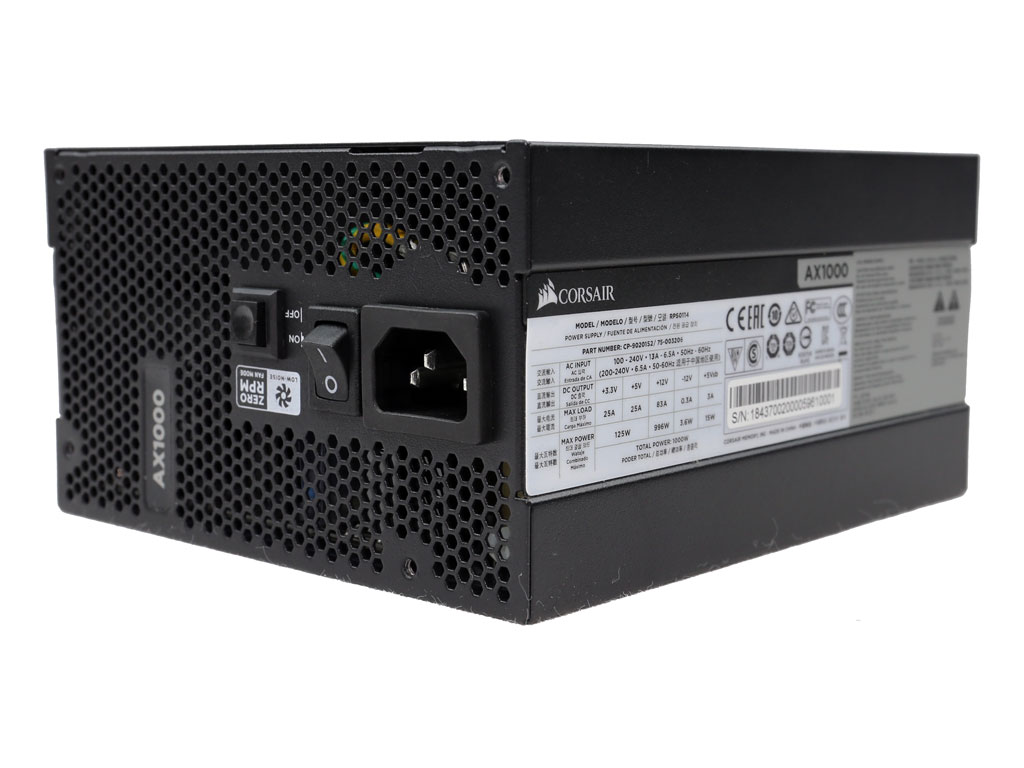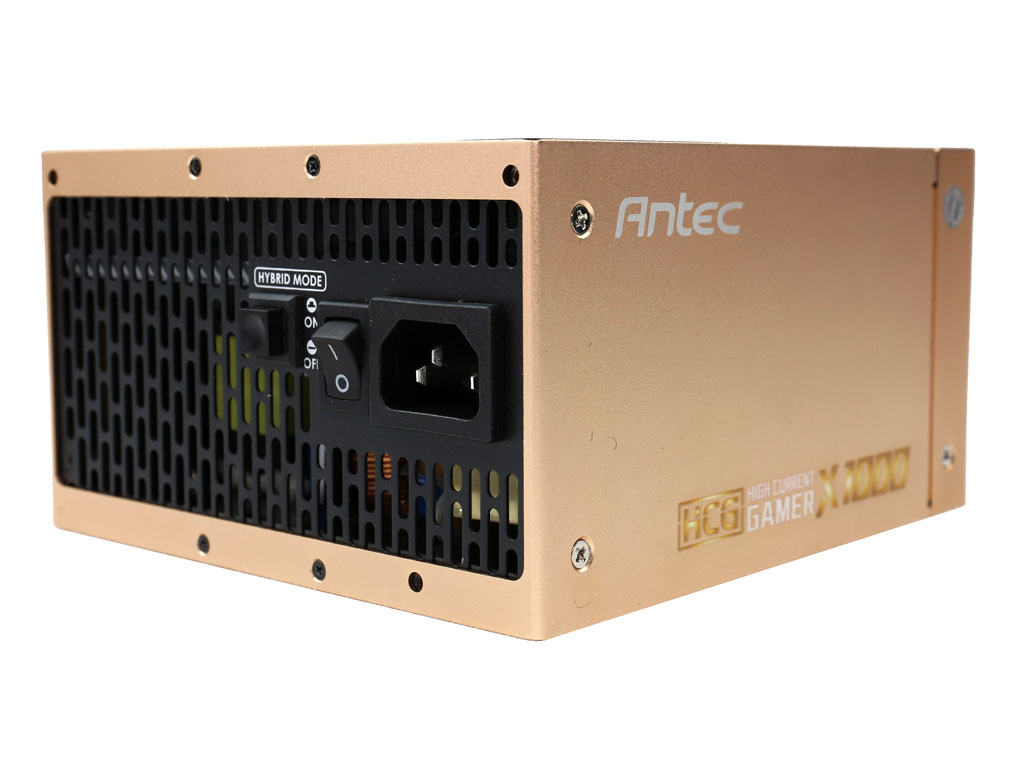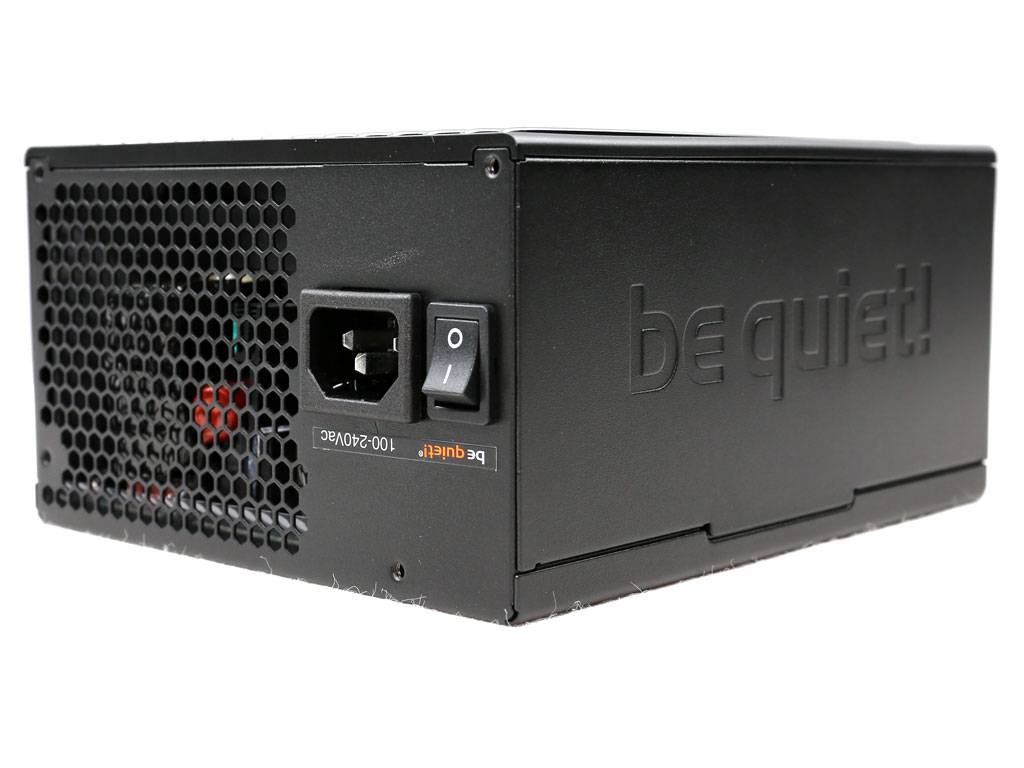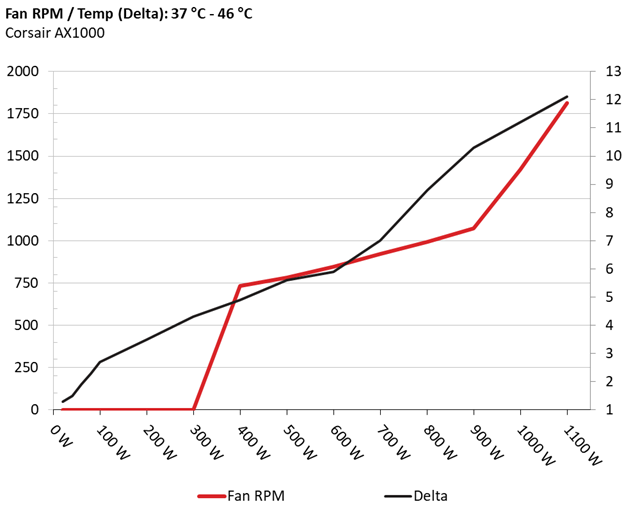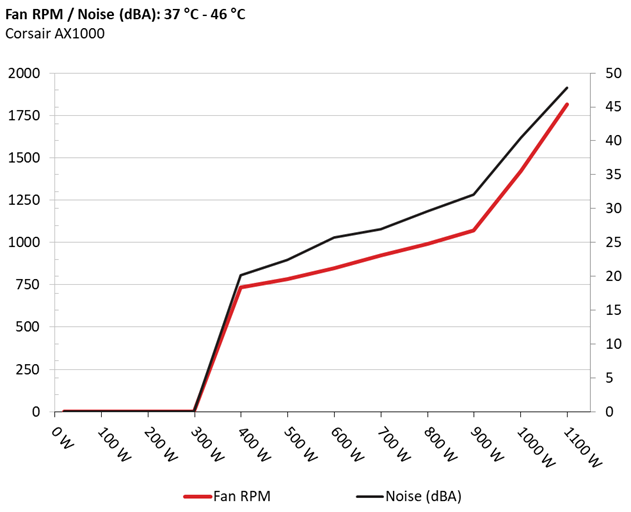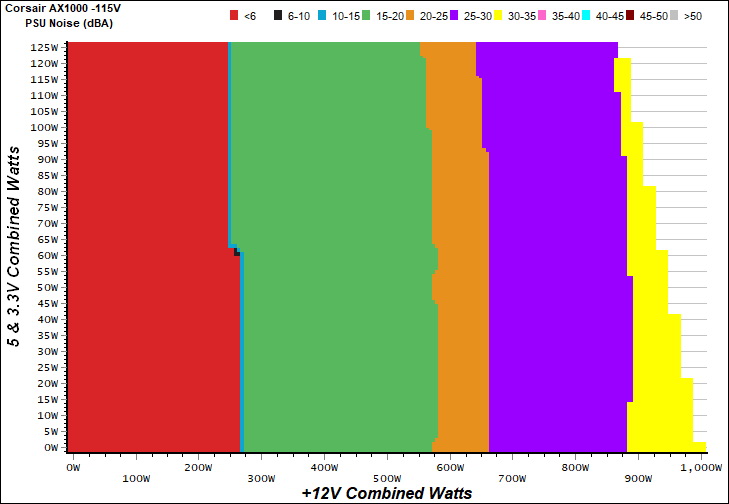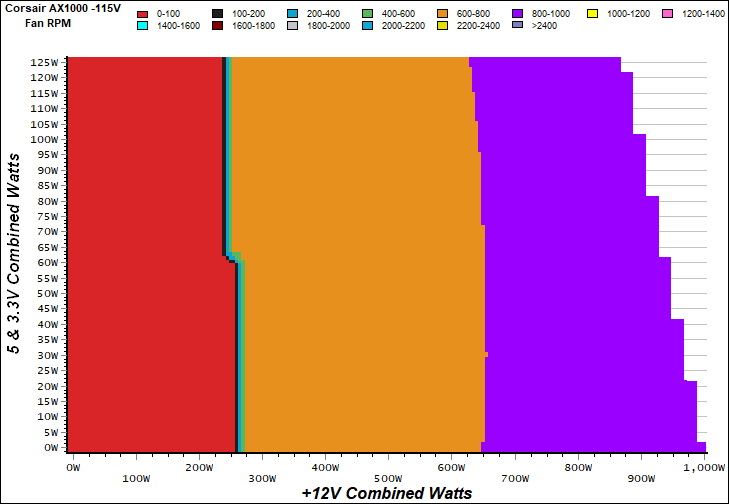Corsair AX1000 PSU Review: Titanium-Class Efficiency, at a Premium Price
Why you can trust Tom's Hardware
Load Regulation, Hold-Up Time, Inrush Current, Efficiency and Noise
To learn more about our PSU tests and methodology, please check out How We Test Power Supply Units.
Primary Rails And 5VSB Load Regulation
The following charts show the main rails' voltage values recorded between a range of 40W up to the PSU's maximum specified load, along with the deviation (in percent). Tight regulation is an important consideration every time we review a power supply because it facilitates constant voltage levels despite varying loads.
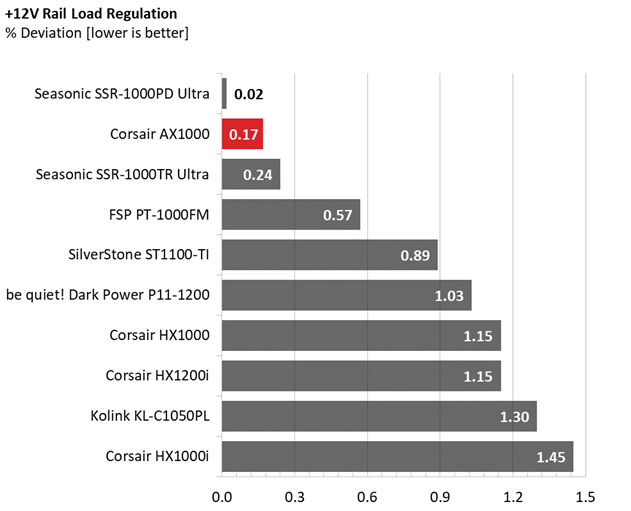
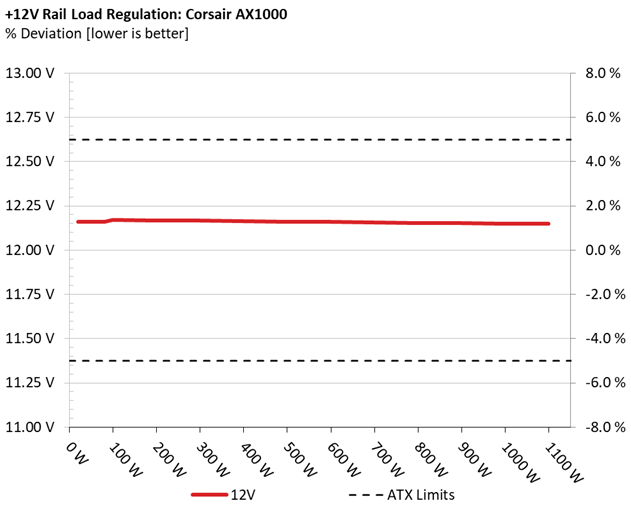
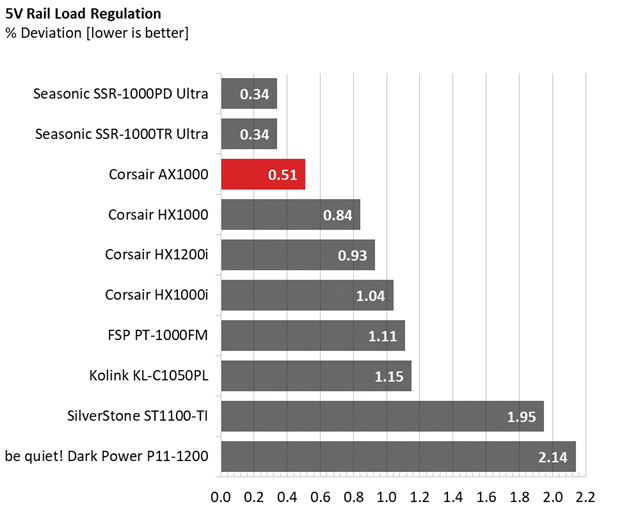
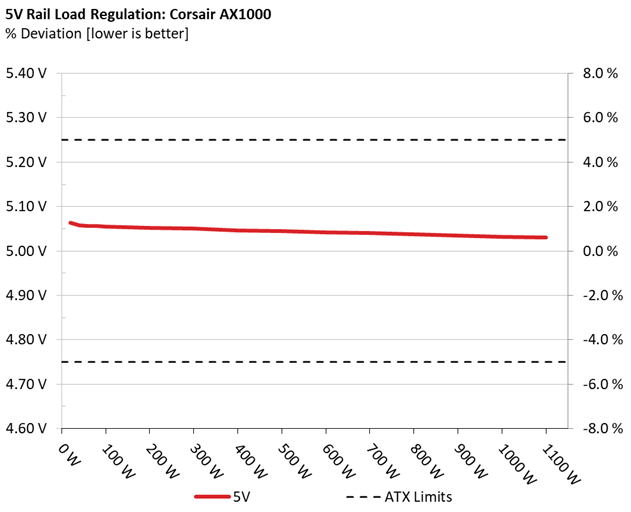
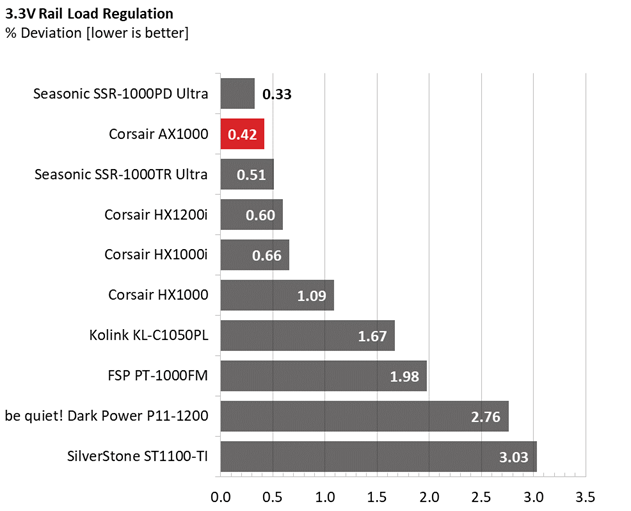
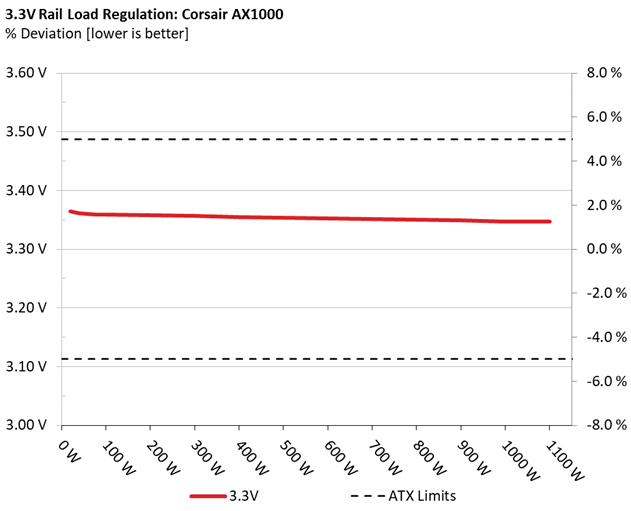
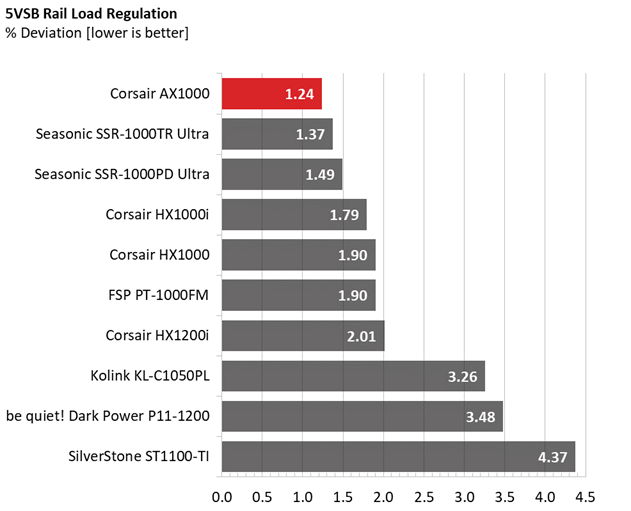
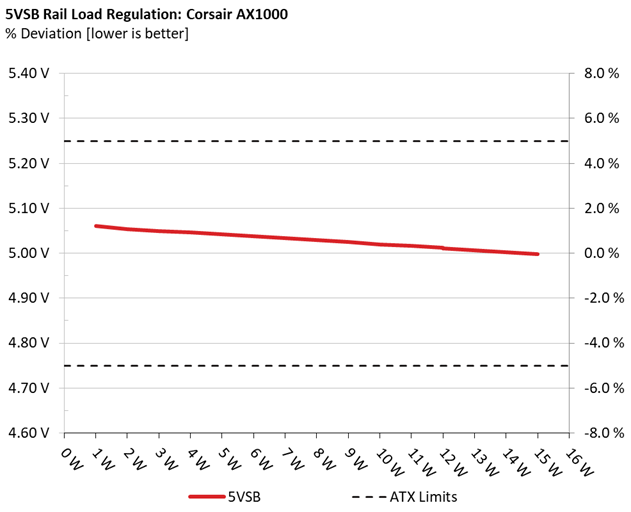
Hold-Up Time
Put simply, hold-up time is the amount of time that the system can continue to run without shutting down or rebooting during a power interruption.
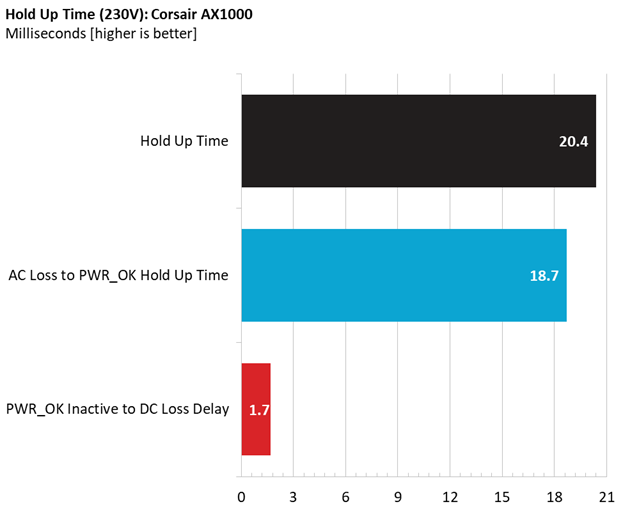
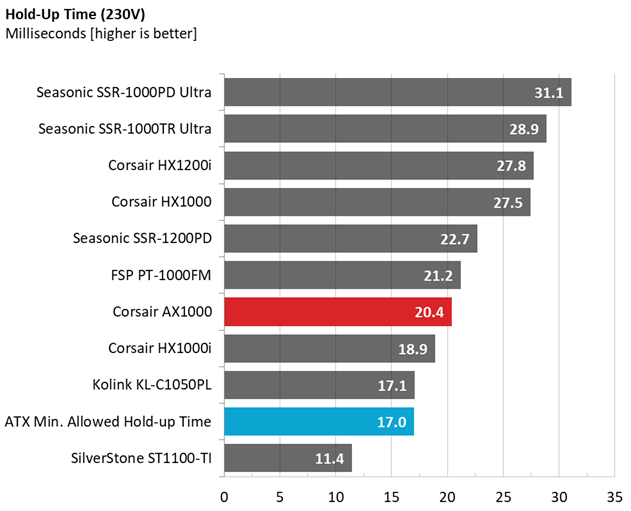
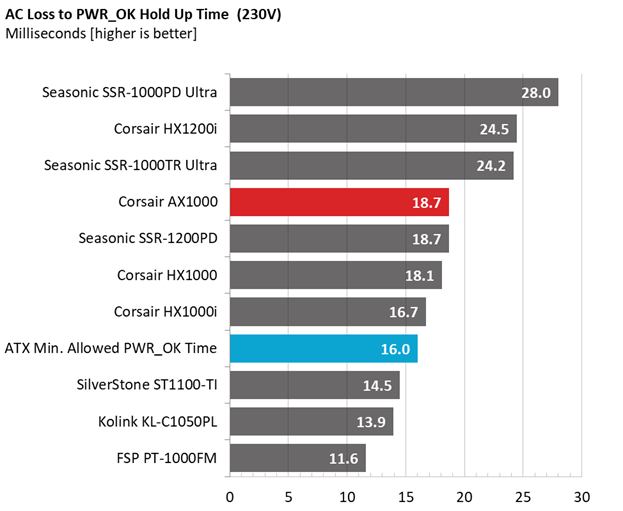
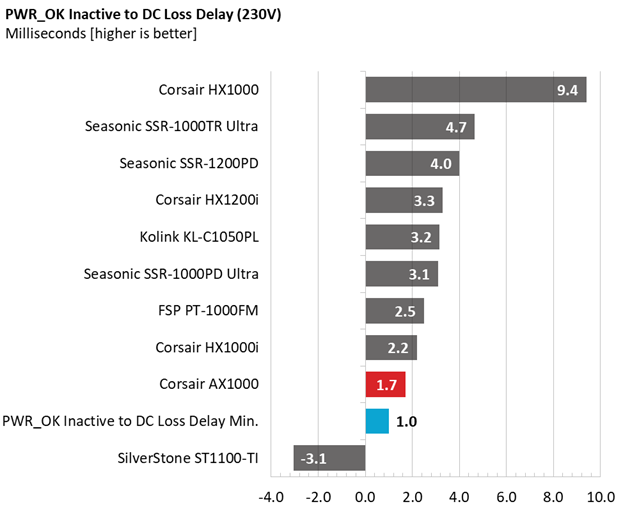
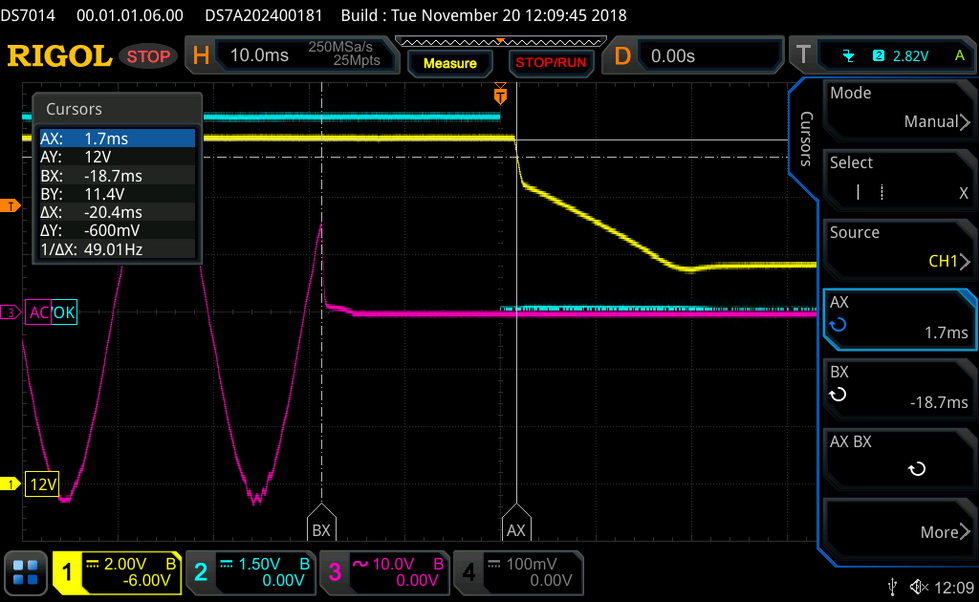
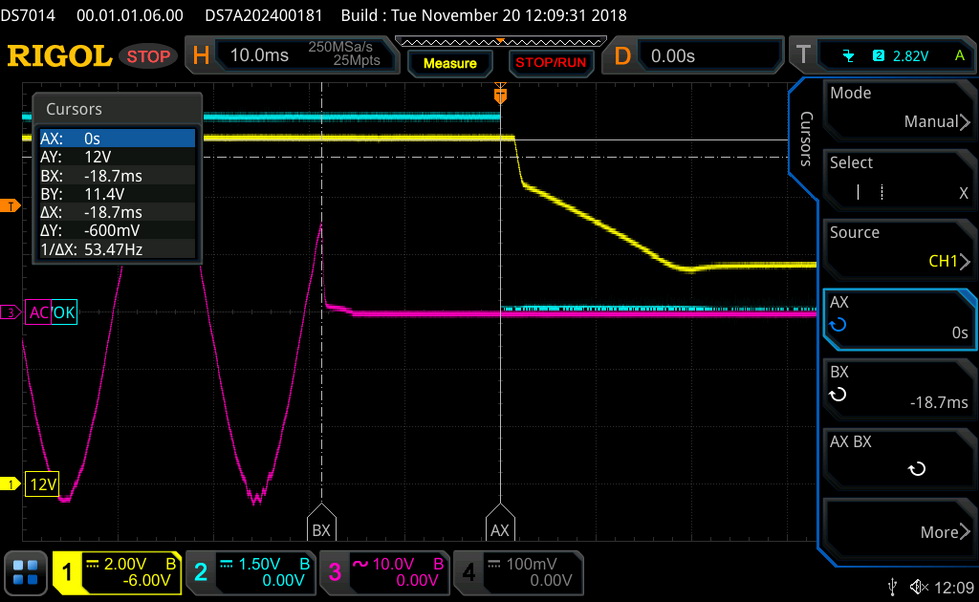
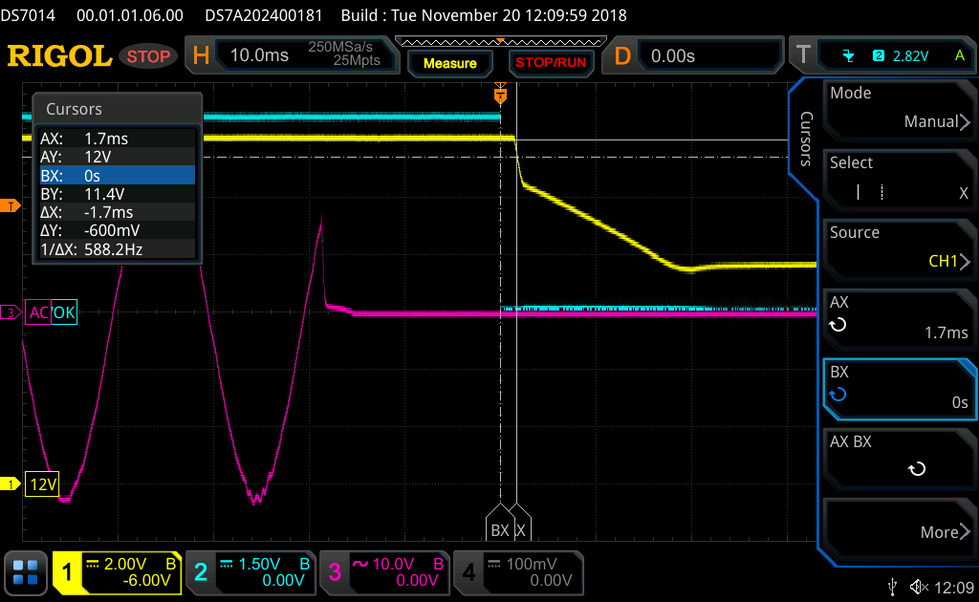
Corsair's hold-up time is long enough to satisfy the ATX specification's requirements and its power-good signal is accurate. We couldn't ask for more from the AX1000.
Inrush Current
Inrush current, or switch-on surge, refers to the maximum, instantaneous input current drawn by an electrical device when it is first turned on. A large enough inrush current can cause circuit breakers and fuses to trip. It can also damage switches, relays, and bridge rectifiers. As a result, the lower the inrush current of a PSU right as it is turned on, the better.
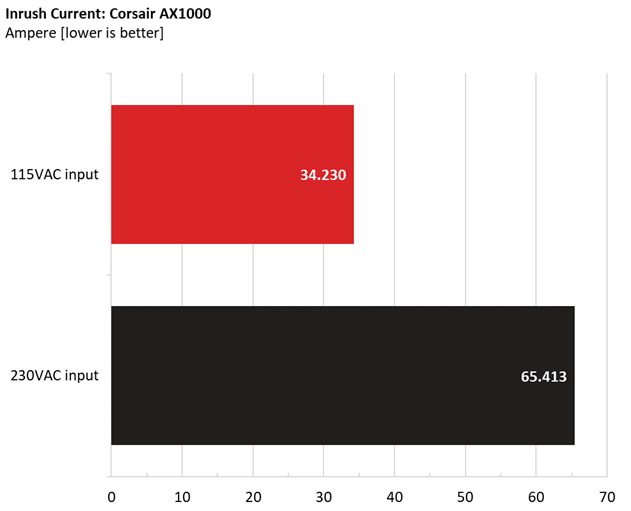
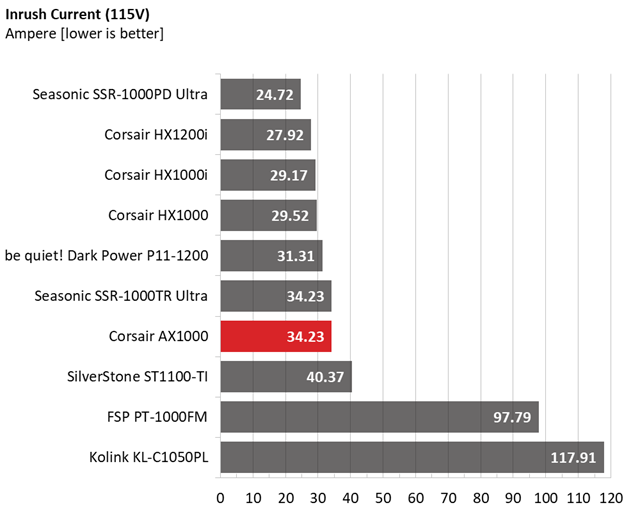
According to our measurements, the AX1000's inrush current is kept under control with both voltage inputs.
10-110% Load Tests
| Test # | 12V | 5V | 3.3V | 5VSB | DC/AC (Watts) | Efficiency | Fan Speed | PSU Noise | Temps (In/Out) | PF/AC Volts |
|---|---|---|---|---|---|---|---|---|---|---|
| 1 | 6.431A | 1.977A | 1.960A | 0.992A | 99.851 | 92.324% | 0 RPM | <6.0 dB(A) | 42.98°C | 0.963 |
| 12.171V | 5.055V | 3.359V | 5.042V | 108.153 | 40.31°C | 115.09V | ||||
| 2 | 13.863A | 2.968A | 2.946A | 1.191A | 199.572 | 93.965% | 0 RPM | <6.0 dB(A) | 44.83°C | 0.981 |
| 12.168V | 5.052V | 3.358V | 5.038V | 212.389 | 41.30°C | 115.10V | ||||
| 3 | 21.617A | 3.462A | 3.423A | 1.391A | 298.969 | 94.309% | 0 RPM | <6.0 dB(A) | 41.58°C | 0.990 |
| 12.166V | 5.050V | 3.357V | 5.034V | 317.010 | 45.87°C | 115.05V | ||||
| 4 | 29.459A | 3.960A | 3.931A | 1.591A | 399.486 | 94.092% | 733 RPM | 20.2 dB(A) | 41.76°C | 0.993 |
| 12.163V | 5.047V | 3.355V | 5.029V | 424.570 | 46.67°C | 115.05V | ||||
| 5 | 36.928A | 4.955A | 4.917A | 1.792A | 499.576 | 93.694% | 782 RPM | 22.4 dB(A) | 41.97°C | 0.993 |
| 12.161V | 5.045V | 3.354V | 5.025V | 533.198 | 47.60°C | 115.05V | ||||
| 6 | 44.407A | 5.947A | 5.904A | 1.992A | 599.720 | 93.133% | 848 RPM | 25.7 dB(A) | 42.62°C | 0.995 |
| 12.159V | 5.042V | 3.352V | 5.020V | 643.938 | 48.48°C | 115.07V | ||||
| 7 | 51.854A | 6.945A | 6.892A | 2.193A | 699.488 | 92.563% | 923 RPM | 27.0 dB(A) | 43.17°C | 0.996 |
| 12.157V | 5.040V | 3.351V | 5.016V | 755.687 | 50.19°C | 115.07V | ||||
| 8 | 59.374A | 7.940A | 7.881A | 2.394A | 800.026 | 91.894% | 993 RPM | 29.6 dB(A) | 43.64°C | 0.997 |
| 12.154V | 5.037V | 3.350V | 5.012V | 870.601 | 52.43°C | 115.07V | ||||
| 9 | 67.217A | 8.442A | 8.359A | 2.395A | 899.322 | 91.255% | 1072 RPM | 32.1 dB(A) | 44.55°C | 0.997 |
| 12.152V | 5.035V | 3.349V | 5.011V | 985.505 | 54.82°C | 115.08V | ||||
| 10 | 74.903A | 8.943A | 8.872A | 3.002A | 999.772 | 90.413% | 1422 RPM | 40.5 dB(A) | 45.22°C | 0.998 |
| 12.150V | 5.032V | 3.347V | 4.998V | 1105.782 | 56.46°C | 115.08V | ||||
| 11 | 83.152A | 8.944A | 8.873A | 3.003A | 1099.823 | 89.670% | 1815 RPM | 47.8 dB(A) | 46.55°C | 0.998 |
| 12.148V | 5.030V | 3.347V | 4.997V | 1226.522 | 58.64°C | 115.10V | ||||
| CL1 | 0.138A | 15.001A | 14.999A | 0.000A | 127.665 | 88.571% | 938 RPM | 27.7 dB(A) | 41.93°C | 0.974 |
| 12.167V | 5.049V | 3.350V | 5.076V | 144.138 | 47.41°C | 115.09V | ||||
| CL2 | 83.013A | 1.000A | 0.999A | 1.000A | 1021.927 | 90.682% | 1376 RPM | 40.3 dB(A) | 45.89°C | 0.998 |
| 12.149V | 5.033V | 3.351V | 5.022V | 1126.939 | 56.05°C | 115.09V |
20-80W Load Tests
| Test # | 12V | 5V | 3.3V | 5VSB | DC/AC (Watts) | Efficiency | Fan Speed | PSU Noise | PF/AC Volts |
|---|---|---|---|---|---|---|---|---|---|
| 1 | 1.171A | 0.491A | 0.474A | 0.198A | 19.323 | 76.572% | 0 RPM | <6.0 dB(A) | 0.784 |
| 12.161V | 5.063V | 3.364V | 5.061V | 25.235 | 115.08V | ||||
| 2 | 2.421A | 0.987A | 0.978A | 0.396A | 39.722 | 86.070% | 0 RPM | <6.0 dB(A) | 0.895 |
| 12.161V | 5.058V | 3.361V | 5.054V | 46.151 | 115.08V | ||||
| 3 | 3.604A | 1.482A | 1.455A | 0.594A | 59.208 | 89.345% | 0 RPM | <6.0 dB(A) | 0.936 |
| 12.160V | 5.057V | 3.360V | 5.050V | 66.269 | 115.09V | ||||
| 4 | 4.857A | 1.976A | 1.961A | 0.793A | 79.645 | 90.898% | 0 RPM | <6.0 dB(A) | 0.953 |
| 12.161V | 5.056V | 3.359V | 5.047V | 87.620 | 115.09V |
Efficiency Charts
Next, we plotted a chart showing the AX1000’s efficiency at low loads, and loads from 10 to 110 percent of its maximum-rated capacity.
Get Tom's Hardware's best news and in-depth reviews, straight to your inbox.
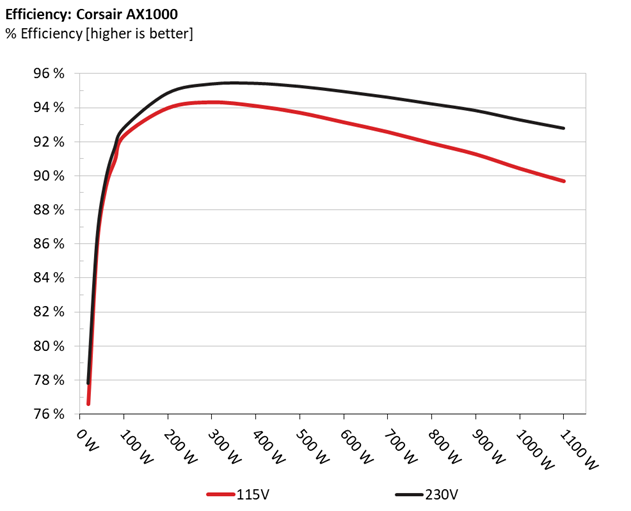
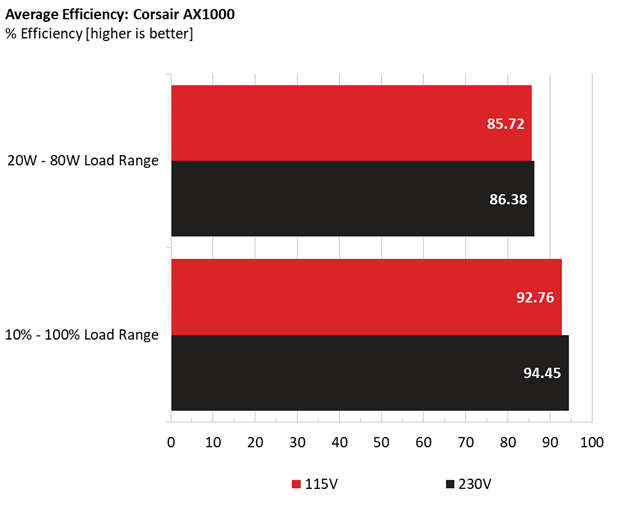
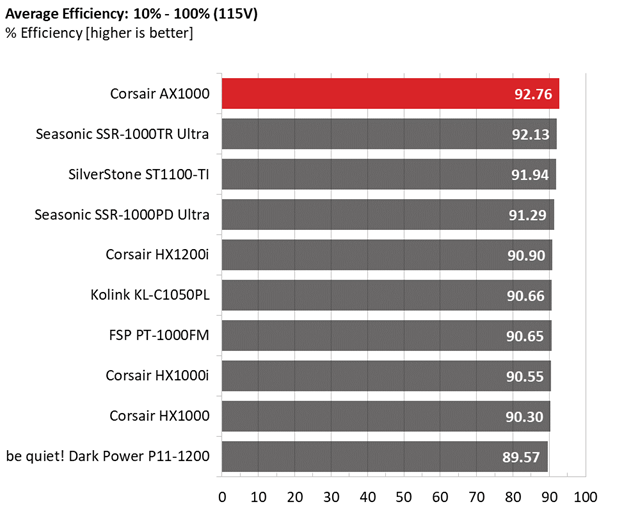
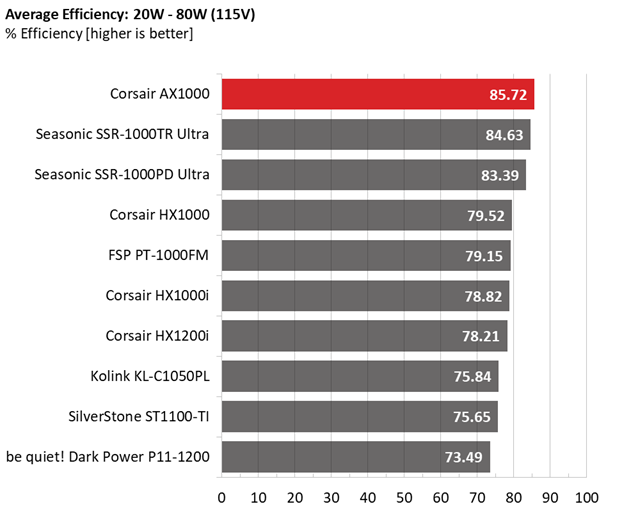
As you can see, the AX1000 is highly efficient under normal and light loads. We're not surprised, of course: this is an 80 PLUS Titanium- and ETA-A+-certified PSU.
5VSB Efficiency
| Test # | 5VSB | DC/AC (Watts) | Efficiency | PF/AC Volts |
|---|---|---|---|---|
| 1 | 0.100A | 0.496 | 73.700% | 0.000 |
| 4.961V | 0.673 | 115.08V | ||
| 2 | 0.250A | 1.239 | 77.534% | 0.143 |
| 4.957V | 1.598 | 115.08V | ||
| 3 | 0.550A | 2.724 | 79.812% | 0.256 |
| 4.952V | 3.413 | 115.08V | ||
| 4 | 1.000A | 4.944 | 79.858% | 0.354 |
| 4.943V | 6.191 | 115.08V | ||
| 5 | 1.500A | 7.404 | 80.768% | 0.409 |
| 4.935V | 9.167 | 115.08V | ||
| 6 | 3.000A | 14.725 | 79.789% | 0.484 |
| 4.908V | 18.455 | 115.08V |
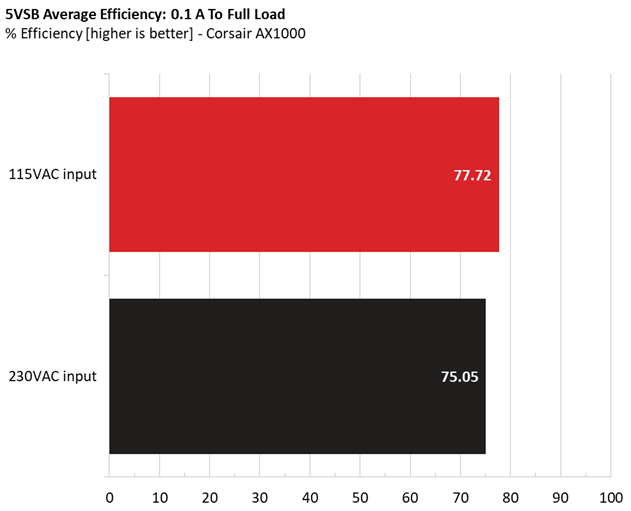
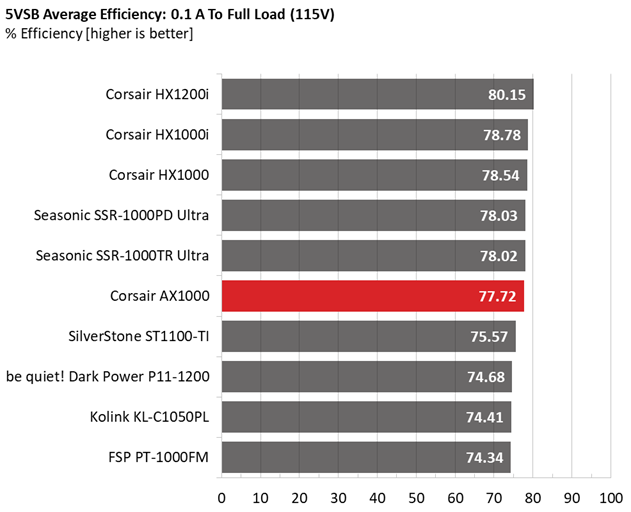
Power Consumption In Idle And Standby
| Mode | 12V | 5V | 3.3V | 5VSB | Watts | PF/AC Volts |
|---|---|---|---|---|---|---|
| Idle | 12.200V | 5.067V | 3.366V | 5.068V | 10.845 | 0.553 |
| 115.1V | ||||||
| Standby | 0.047 | 0.005 | ||||
| 115.1V |
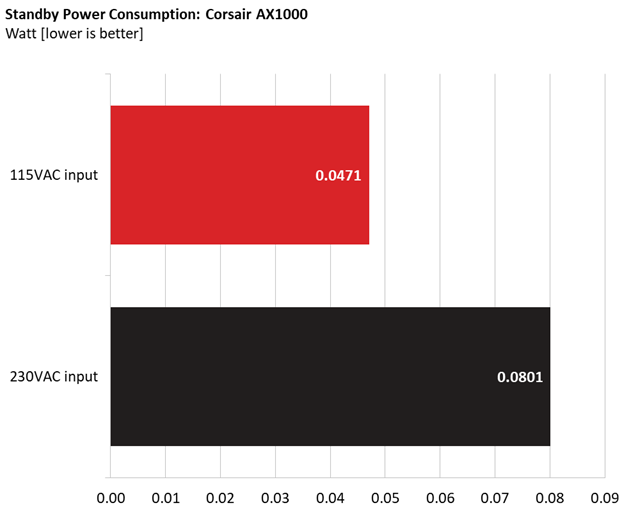
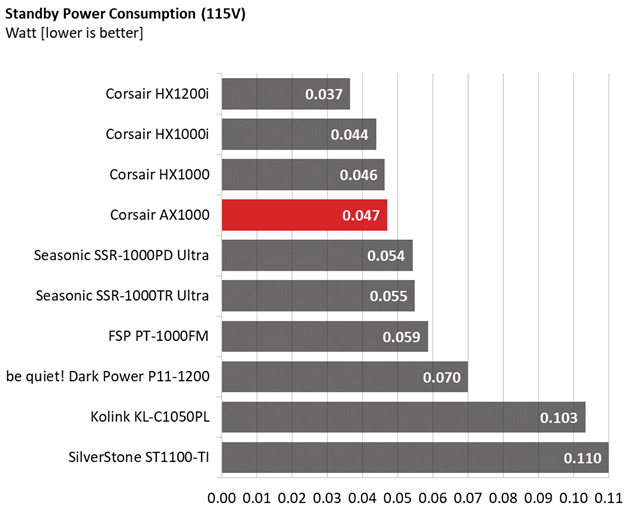
Fan RPM, Delta Temperature, And Output Noise
All results are obtained between an ambient temperature of 37°C (98.6°F) to 46°C (114.8°F).
The fan does its job well, given the temperature differences that our equipment recorded.
Under loads as high as 300W, the fan doesn't spin. Between 300W and 900W, the fan's rotational speed stays fairly low, limiting noise output as well. It's only under very high loads (and elevated temperatures) that the acoustics become bothersome.
The following results were obtained in an ambient environment kept between 30°C (86°F) and 32°C (89.6°F).
Even under normal operating temperatures, the passive mode doesn't last long if load on the minor rails increases too much. Apparently, the DC-DC converters responsible for handling the 5V and 3.3V rails need active cooling once they're pushed hard.
Overall, though, Corsair's fan profile is conservative, even under demanding loads.
MORE: Best Power Supplies
MORE: How We Test Power Supplies
MORE: All Power Supply Content
Current page: Load Regulation, Hold-Up Time, Inrush Current, Efficiency and Noise
Prev Page Features and Specifications Next Page Protection Features, DC Power Sequencing, Cross-Load Tests and Infrared Images
Aris Mpitziopoulos is a contributing editor at Tom's Hardware, covering PSUs.
-
marcelo_vidal evga 430 die in one year =) if you do the math you will spend 370 on cheap evgas or you can pay 27 dollars for year to get a monsterReply -
wdnemesis I would like to see Cable Mod team up with Corsair and seasonic. I prefer cable Mod cables. The Corsair ones look fine but most people that purchase this type probably use modded cables as well. This PSU would be amazing with that option.Reply -
drtweak I just got a AXi1200i on Newegg. Damn good price. Was on sale for 149.99 + a 20 dollar mail in rebate. I love using it with the Corsair link software and watching this baby be 91-93% Efficient all the time. I had a CM600 before which was fine, but between planed upgrades soon, and also combining my plex server with my gaming PC, 600 wasn't enough power, amps, or connectors to power a FX8320 OC'ed, GTX 960, and 13 hard drives lolReply -
PapaCrazy Reply21722950 said:I just got a AXi1200i on Newegg. Damn good price. Was on sale for 149.99 + a 20 dollar mail in rebate. I love using it with the Corsair link software and watching this baby be 91-93% Efficient all the time. I had a CM600 before which was fine, but between planed upgrades soon, and also combining my plex server with my gaming PC, 600 wasn't enough power, amps, or connectors to power a FX8320 OC'ed, GTX 960, and 13 hard drives lol
Hard drive power requirements can sneak up on you. I once plugged too many HDDs into a SATA line and started having drives randomly disconnect. I think I might have corrupted them that way.
-
jimmysmitty Reply21722950 said:I just got a AXi1200i on Newegg. Damn good price. Was on sale for 149.99 + a 20 dollar mail in rebate. I love using it with the Corsair link software and watching this baby be 91-93% Efficient all the time. I had a CM600 before which was fine, but between planed upgrades soon, and also combining my plex server with my gaming PC, 600 wasn't enough power, amps, or connectors to power a FX8320 OC'ed, GTX 960, and 13 hard drives lol
I got a AX860i for less than retail as I worked at a repair shop so discount about 5 years ago and its still going. its a great little unit. I still think the AXi series is one of the best PSUs out there and worth the money. -
Dark Lord of Tech I have the RM1000i White Special Edition which was limited to 100 total units. Great PSU.Reply -
BoredErica From 0-300w it seems cooler than passive 600w Seasonic PSU. Did you remeasure the PSUs since a year ago?Reply
